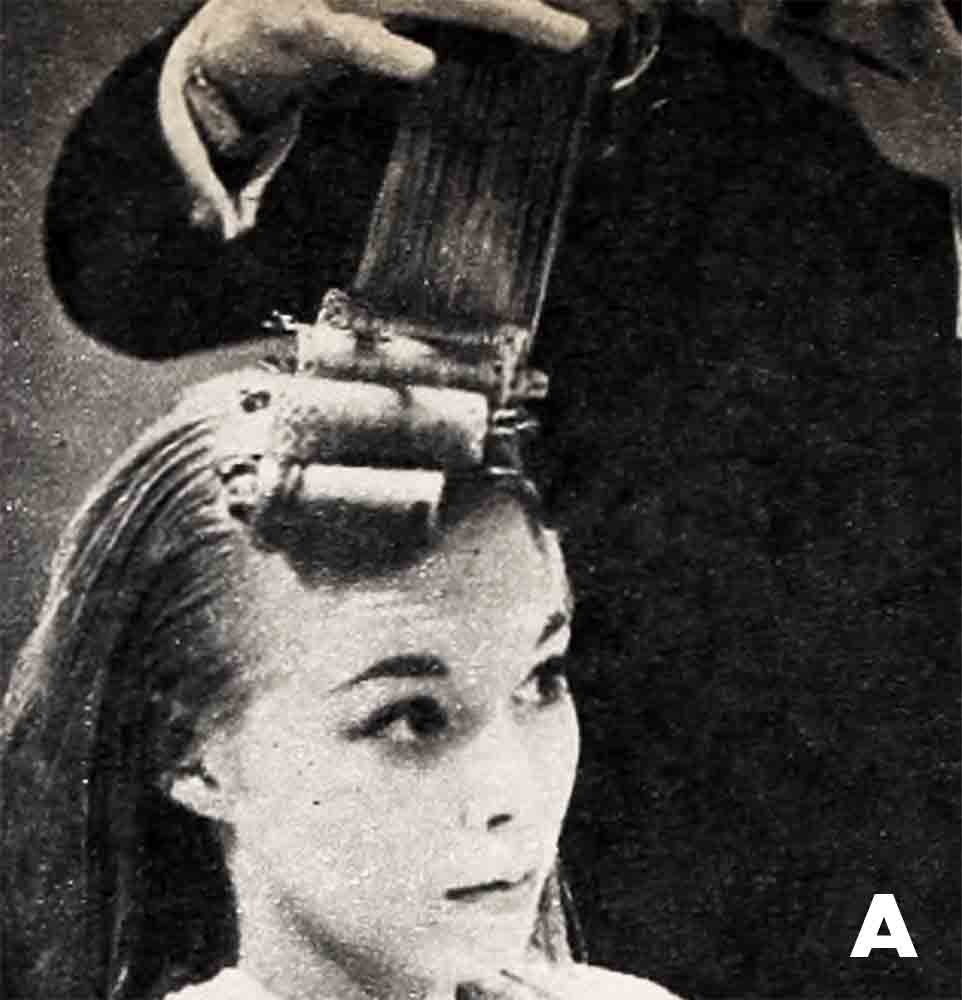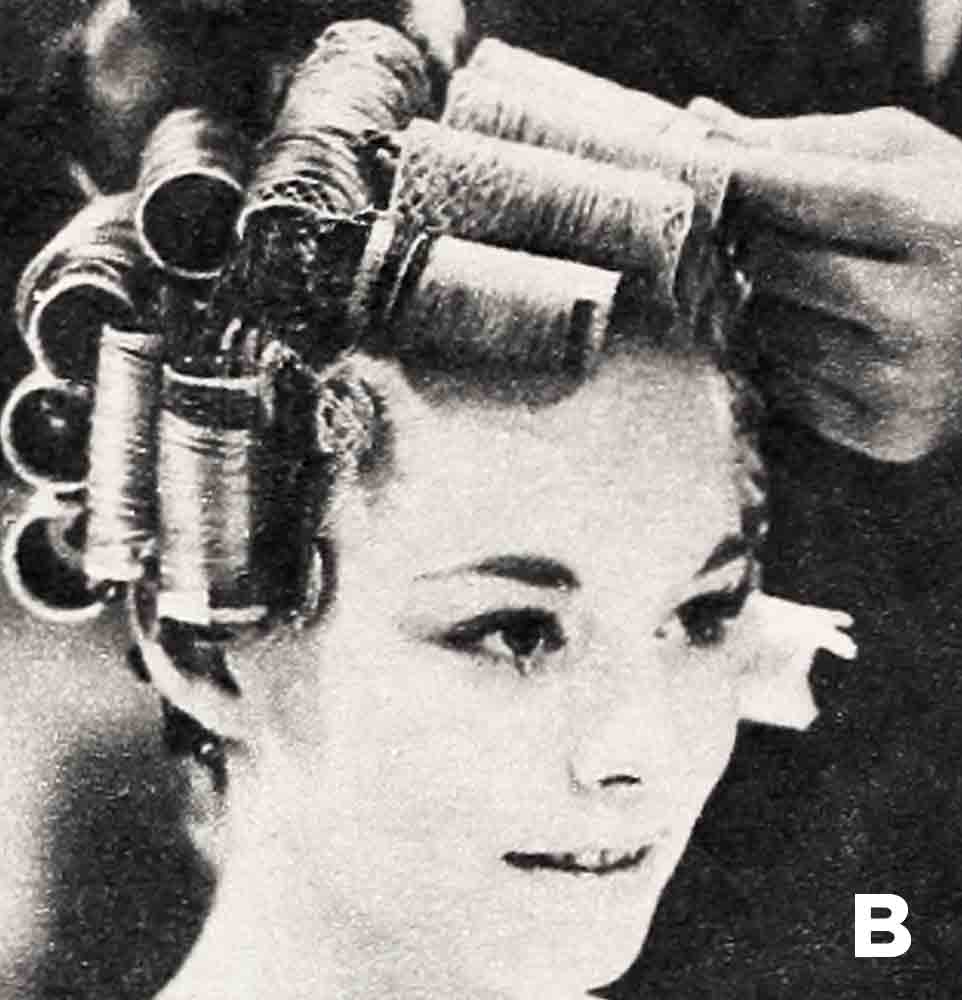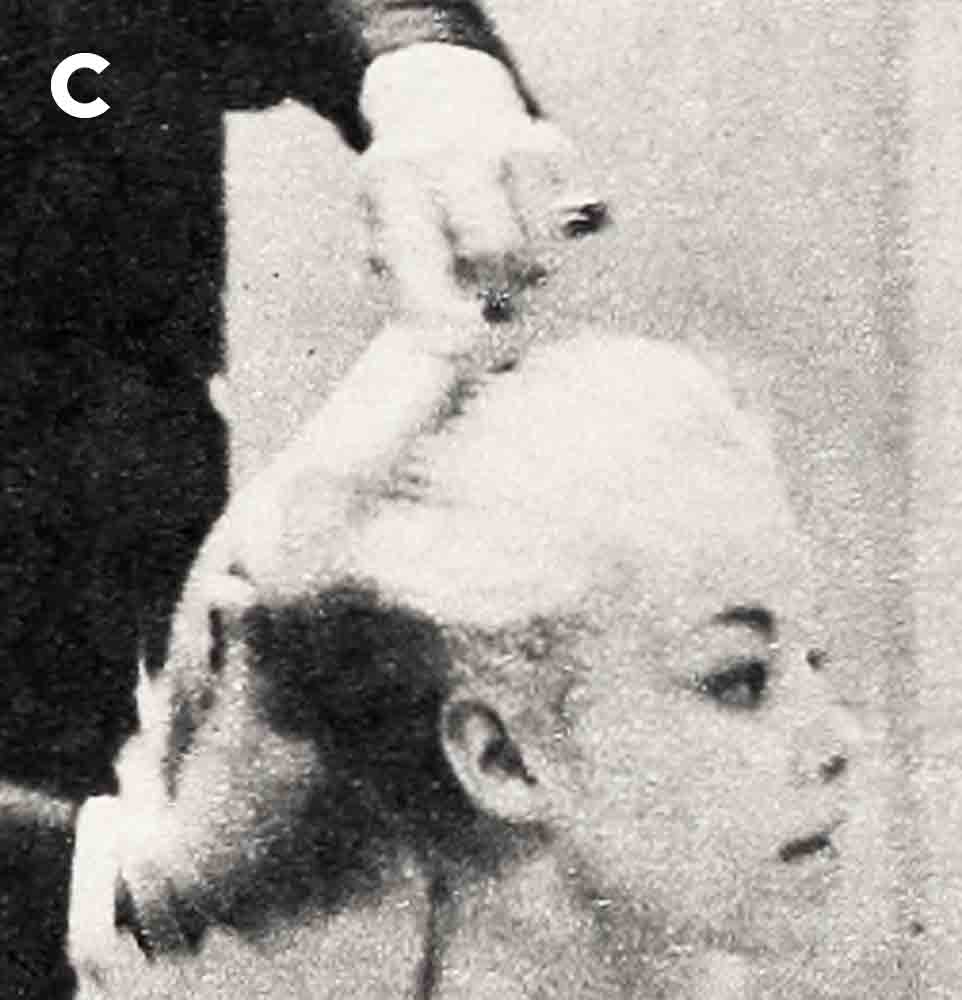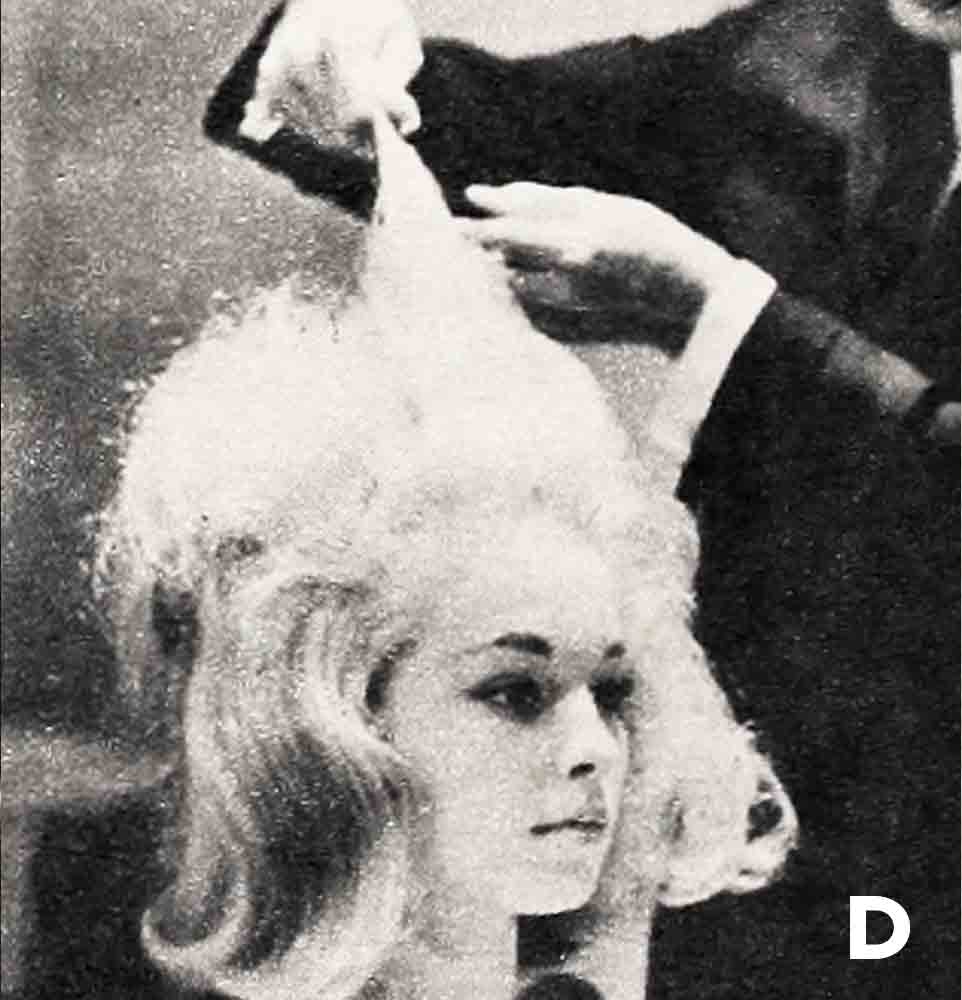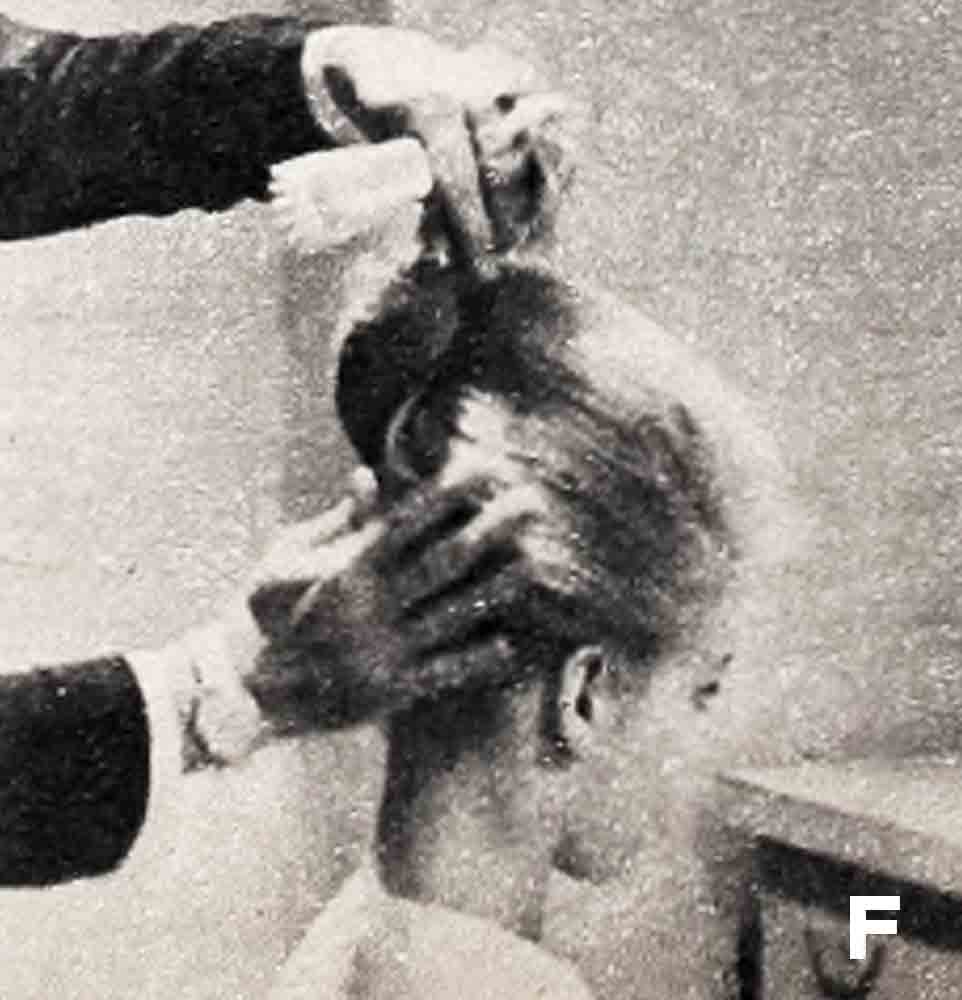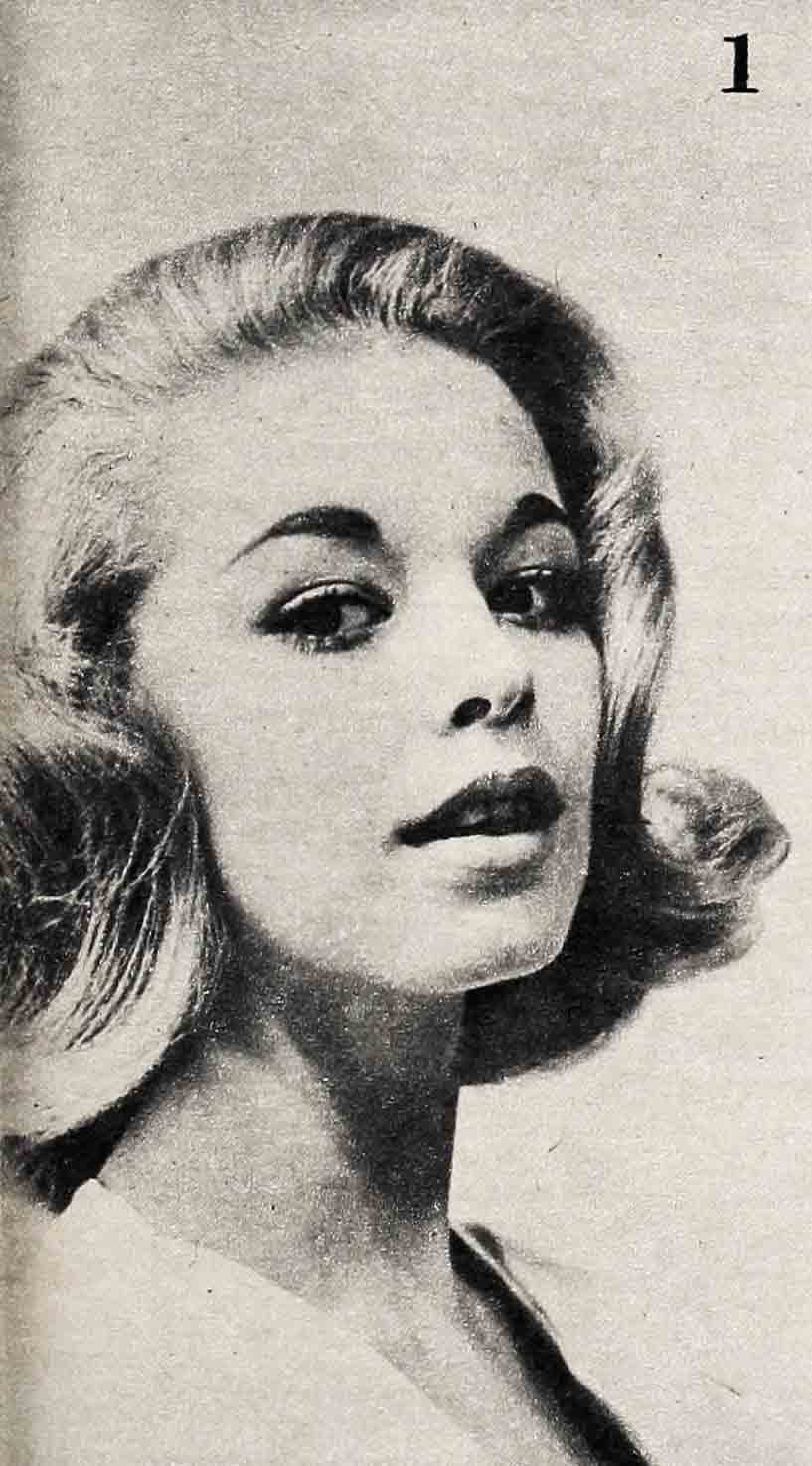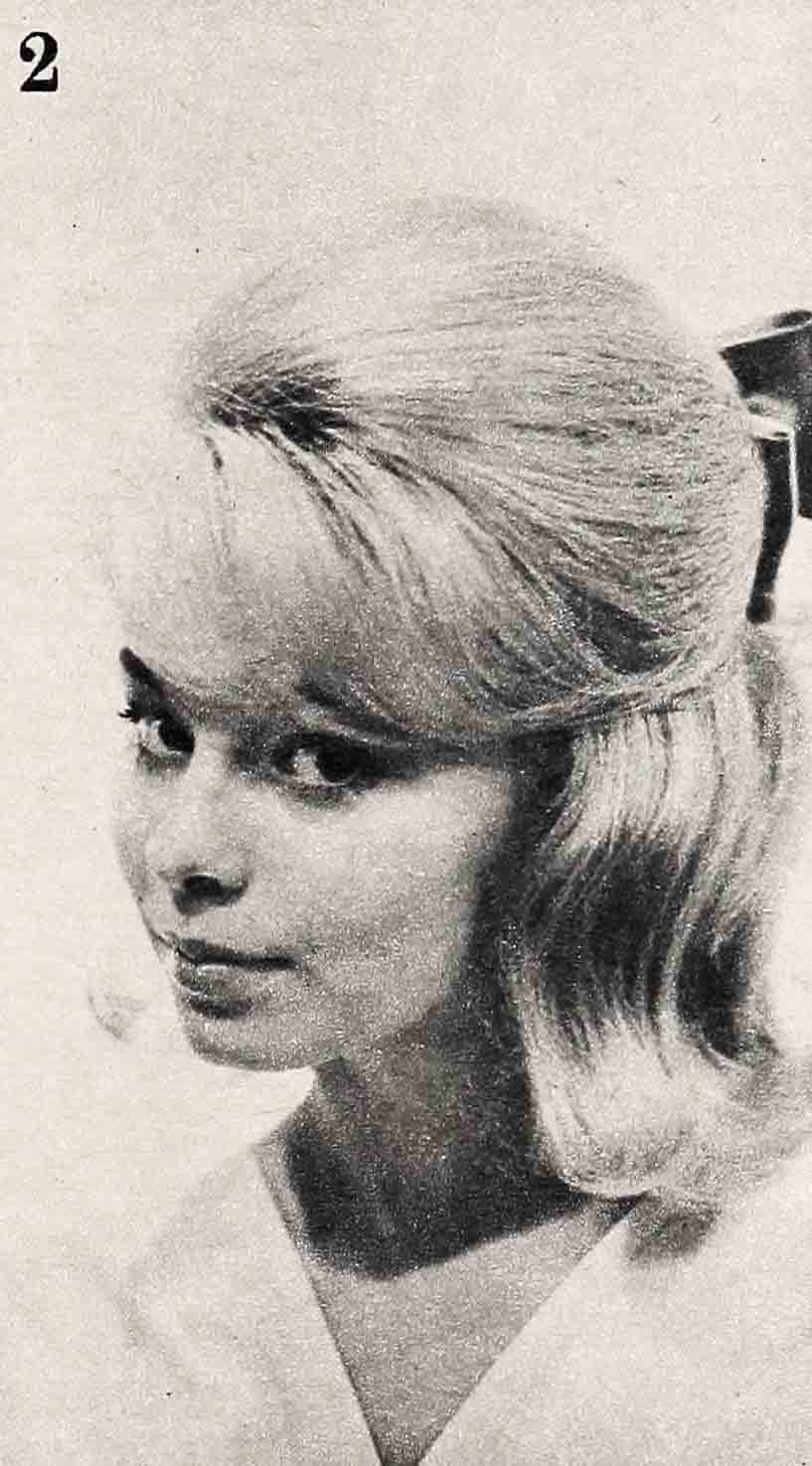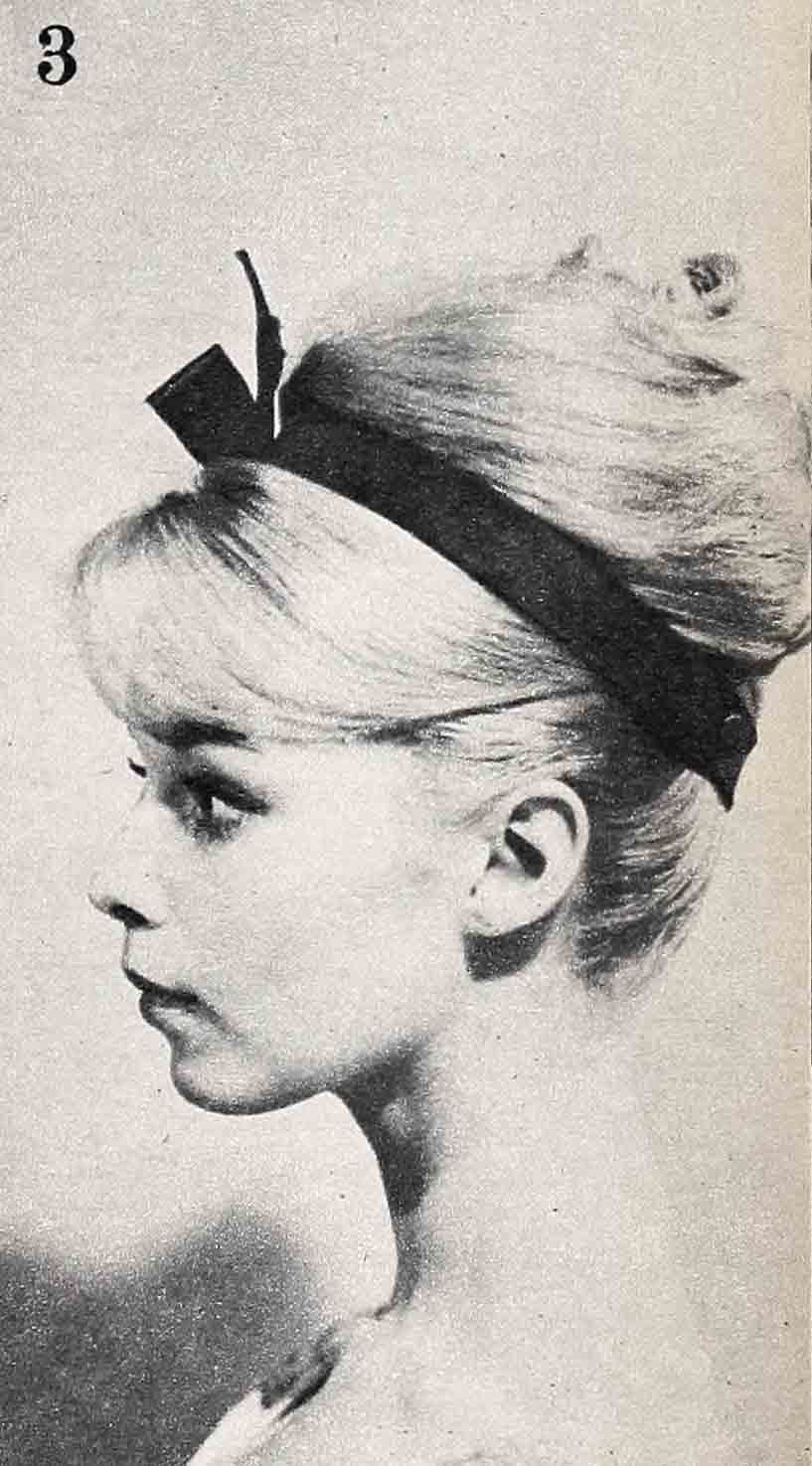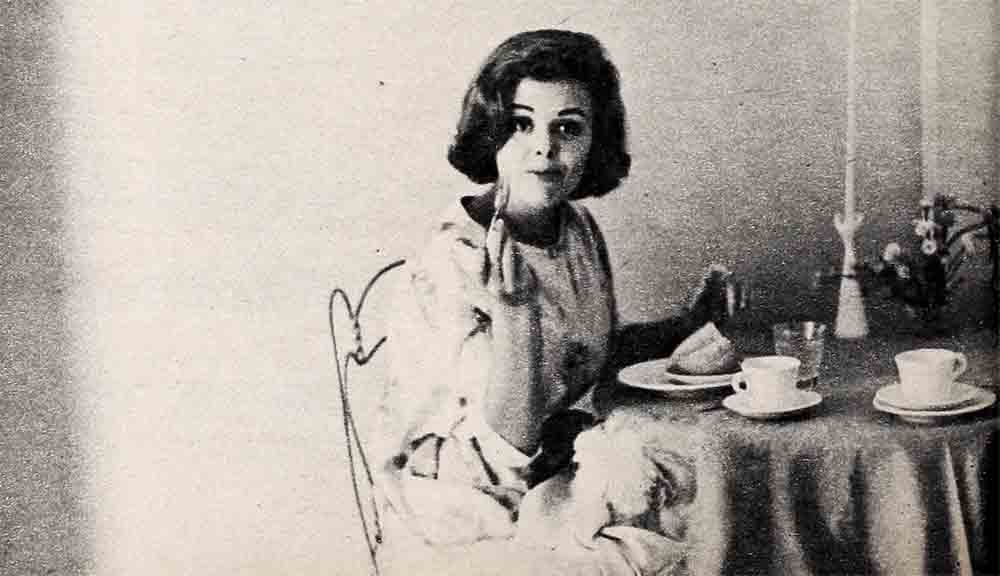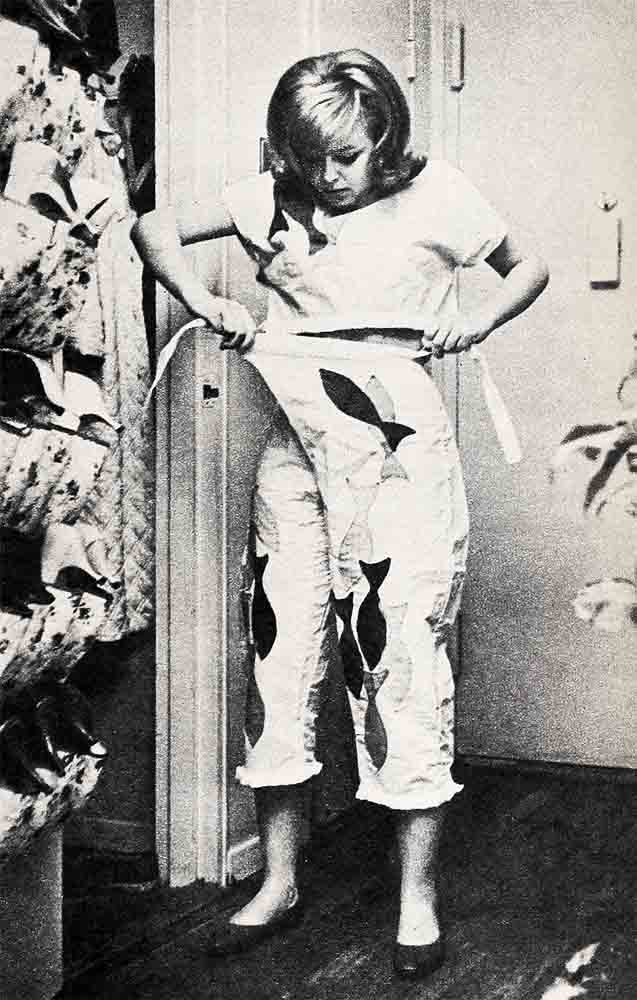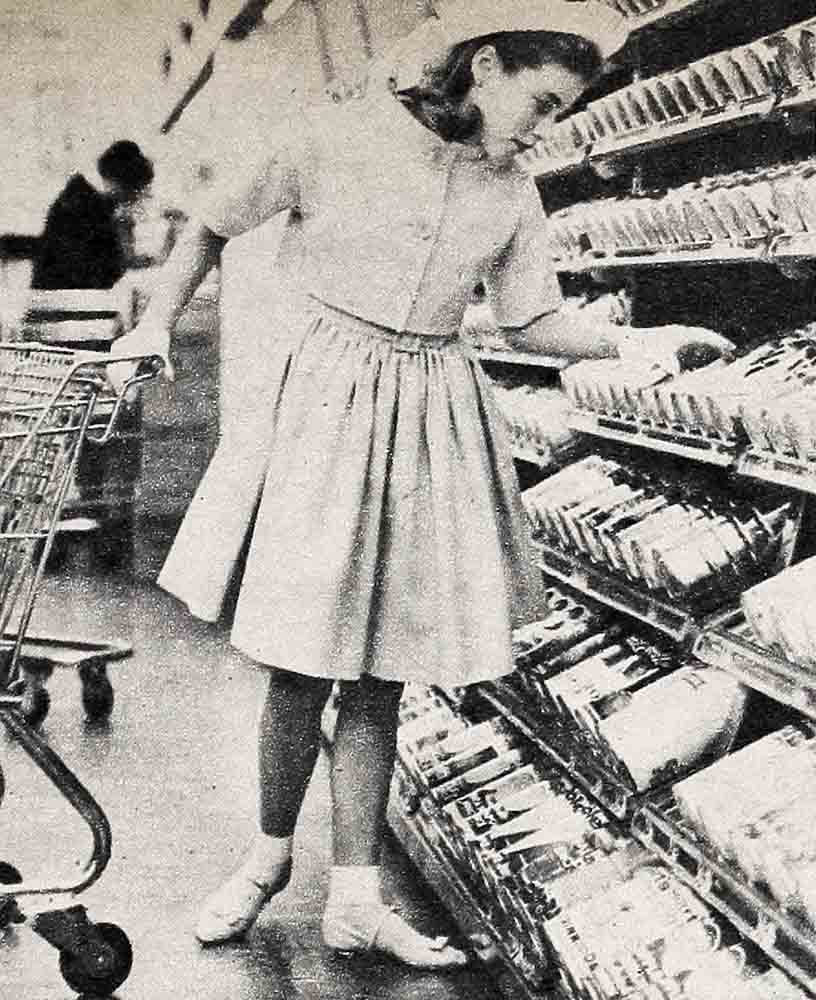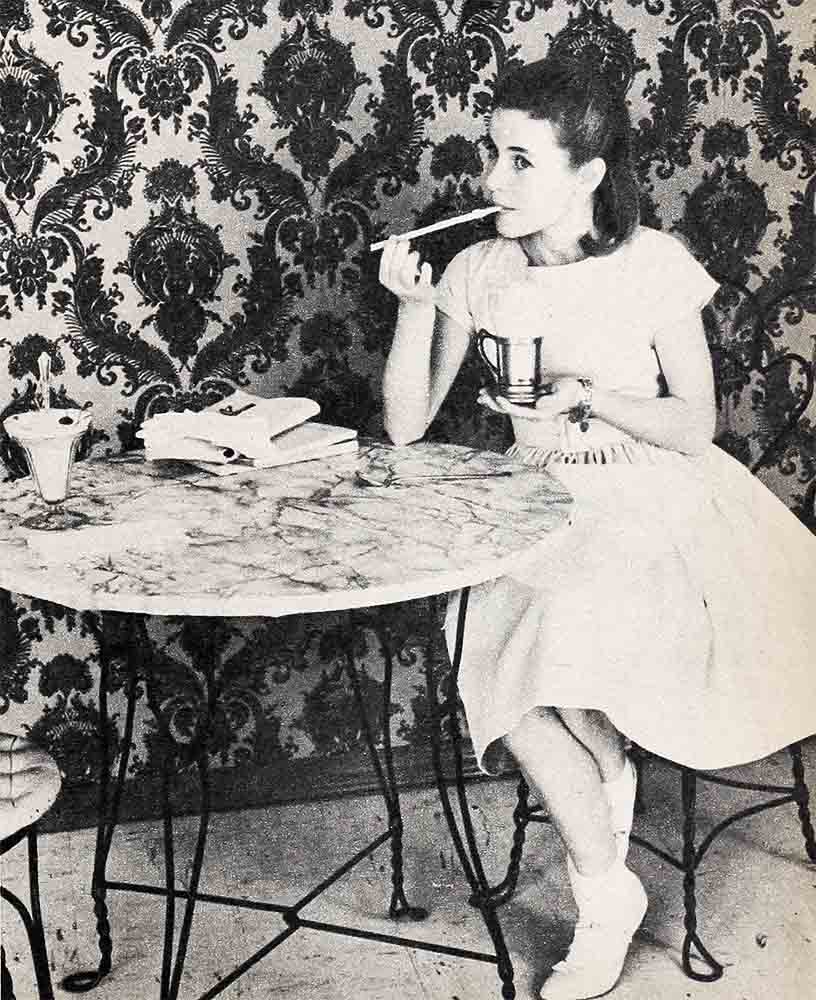
Your Best Buy In Beauty!
3 hairdos for the price of one
YOUR BEST BUY IN HAIRDOS FROM KENNETH, JACQUELINE KENNEDY’S HAIRDRESSER
The three-in-one hairdo created tor Photoplay by Lilly Dache’s famous Mr. Kenneth was made to order for busy women—from teenage cheerleaders to hurried homemakers—who simply don’t have the time or money to go to the beauty parlor every time they want a change of hair style. It’s so adaptable that by simply following the setting directions on the right, you can produce three different styles that will take you gracefully from school or supermarket to the most glamorous night out.
Will the three-in-one be becoming to you? Mr. Kenneth told us (and he studies the beauty problems of thousands of girls a year) that too much fuss is made about the shapes of faces, eyes and noses when it comes to choosing a hair style. Unless you have a really (and rarely) severe problem involving too round or too long a face, you need think about only two things: the skill with which your hair is cut, and the confidence with which you wear it. For the former, a professional beautician is a necessity. For the three-in-one, ask him to cut your hair chin-length (a little shorter than Jill Hayworth’s is best for most girls) and not to layer or taper it (especially if your hair is thin or fine) but to cut the ends blunt and even. It will need a trim only once a month.
As for confidence—that comes from many things, among them: knowing your hair is a becoming shade (if it isn’t, consider a real change, professionally done; or a mild color rinse you can do yourself); knowing it is clean (shampoo it not by a schedule but whenever it gets dirty); knowing it is in top condition (brush it lying across a bed with your head lower than your body, bringing the brush up and back to bring the blood to your scalp and distribute your hair’s natural oils evenly, no matter whether your hair is dry, oily or in-between) and knowing it is well-groomed. (A light spray will help, but don’t try to give your hair a concrete finish, please!) How often will you have to set your hair? That depends. Soft hair that hasn’t been permanented, or hair that isn’t elastic, will need to be set more often. A few lucky people can get by on an occasional hour-long pin-curling, but most hair needs a daily setting. Mr. Kenneth has found teenagers have the most time and patience for good haircare; if you’re too busy to set yours often, don’t despair. The cut itself is designed so simply and well that even if your setting doesn’t last, a good brushing will give you a neat, attractive hair style all by itself! And don’t be afraid that your hair, so simply arranged, will “look like everyone else’s.” Its own individual texture and color will make the three-in-one hairdo uniquely, personally yours!
Jill Haworth learns that what goes up can come down beautifully—three completely different ways. It’s hair magic created especially for you—by the inimitable Kenneth.
BASIC TIPS: Step A: An all-important part of setting the perfect hairdo—Kenneth tips each section of wet hair with end-papers to guard against “fish-hooks” and split ends. Jill’s delicate baby blonde hair needs protein shampoo and setting lotion to keep it soft and manageable. Step B: The finished hair-set—notice large rollers are placed diagonally across the crown to allow a greater variety of soft-looking comb-outs. Clip-curls give extra body to curls around the back and hair-line. Step C: The brush-out. Kenneth brushes hair upward to stimulate the scalp, then brushes the setting into place as shown here in long, downward strokes. The finished comb-out (number 1, above) is smooth over the crown, silky, flips out in soft curls at the ends. Step D: The second comb-out combines a smooth flipped-out back with a soft, puffed crown, (number 2, above). To do this, Kenneth first teases (or backcombs) the entire crown section. Taking a few strands of hair at a time and holding it straight up in the air, he combs towards the scalp. Step E: Smoothing down takes a light touch and plenty of patience. Kenneth coaxes the front into a sweep of bangs, secures the light twist at the back. This becomes a “foundation” for the velvet bow. To hold this casual look in place—a hair spray mist. Step F: The third hairdo of this magic trio—a French twist that rises from smooth, well-brushed sides to a pretty knot high at the back. Kenneth arranges the curls lightly, pins the twist from left to right, sprays again to insure against wisps. The coif (number 3 above) is then tied with a ribbon above side-tilted bangs for evening glamour.
a new do-it-yourself diet
YOUR BEST BUY IN CALORIES, STAR-TESTED BY DEBORAH WALLEY
One day Deborah Walley went into a store, tried on a dress in her usual size five—and gasped. The dress didn’t fit. She looked at herself squarely in the mirror and said, “Deborah, you’ve eaten yourself out of a size five and you may have eaten yourself out of a career!” A few days later, Columbia called and told her that if she could lose twelve pounds before they were ready to start production, she would be the new Gidget. This confirmed her worst suspicions.
She headed straight for her doctor’s, and his report was the first bit of encouragement she’d had all day. She was in perfect health, he told her, and if she had the will power, there wasn’t a reason in the world why she couldn’t lose the weight. Not a reason except a growling stomach, she thought.
But she did it. She lost the weight, looked great and got the part. Not only that, Buena Vista saw her and signed her for a role in “Bon Voyage.” How did she do it? Here are the rules she followed:
1- Go to your doctor for a checkup and a basal metabolism test (this determines how fast your body burns the food you eat). Have a frank talk with him about the kind of life you lead—how much exercise you get. how much sleep, what meals you skip, what your crowd eats on dates. Then let him determine your ideal weight—meaning what you ought to weigh.
2- Estimate the number of calories you need to maintain your present weight. You can approximate this by counting twenty calories for each pound of your ideal weight, plus four calories per pound of overweight. For example, suppose your weight is 110 and your doctor tells you that your ideal weight is 100. You would need to consume 2040 calories a day to maintain your present over-weight (100 lbs. X 20 calories = 2000 calories, 10 lbs. overweight X 4 calories = 40 calories, 2,000 + 40 = calories). Of course, you don’t want to keep your present weight—you want to take off ten pounds. Nothing could be easier—even the math is simple.
3- Cut your calorie intake by 3500 for each pound you want to lose. It doesn’t matter if you do it in a week, a month or a year. Any normal, healthy person who drops 3500 calories from the number he needs to maintain his present weight will also drop one pound. The safest, most comfortable way for most people to diet is to take off one pound a week. That ominous-sounding 3500 calorie reduction is then spread out over seven days—only 500 calories per day. By subtracting 500 from the figure you arrived at for maintaining your present weight you will have the number of calories you may eat each day and still lose a pound a week.
4- Decide how you’re going to budget your new daily calorie aIlowance. To satisfy your doctor, you must eat foods from the five basic food groups: fruits and vegetables, proteins (meat, fish, eggs, poultry), dairy foods (including milk, cheese and yogurt), cereals (including bread) and fats. To satisfy your mother, you’ll have to eat foods that fit into the family meal-plan and budget. And to satisfy yourself, you’ll want to eat foods you like—including some high-calorie, non-essential treats! Can you fit all this into your daily calorie allowance? Of course you can! All you have to do is select the best calorie buys and avoid the bad ones. By making enough good buys in the course of a day, you’ll find that you have several hundred calories left over with which to satisfy yourself—with a hot fudge sundae, a chocolate malt or anything else your heart desires. There isn’t a girl in the world who can’t stay happy on a diet like that! You’ll need a calorie counter—your doctor may be able to supply one, or you can buy one at any drug store. To show you how calorie-shopping works, Photoplay has selected some typical good buys, as well as some especially bad ones. Pick the good ones whenever you can. Take advantage of low-calorie bargains in treats as well as basic foods, in filling foods as well as slimming ones. You’ll soon find that it can be fun to lose a pound a week!
Just keep one important factor in mind: No matter how carefully you plan your diet, it won’t work if your will power isn’t working. It may be a little difficult to plan your calorie intake at first, but once you make a habit of it, it will become second nature to know which foods to choose and which to avoid. And remember, keep your calorie counter with you at all times. Start your diet today—and good luck!
look like a million on a piggy-bank budget
YOUR BEST BUY IN FASION FROM DESIGNER OLEG CASSINI
“High fashion is for the woman with time and money. Good fashion is for the woman with a budget and common sense,” says Oleg Cassini, the famed designer and fashion coordinator to Jackie Kennedy. What is good fashion? According to Mr. Cassini, “It is knowing yourself and dressing to suit your figure, personality and pocketbook. Good fashion is making your own style. Clothes today are short. but if you do not have good legs, have the good sense to wear your clothes just a bit longer. If your figure is less than perfect, make use of “camouflage” fashions like overblouses or no-waist dresses. But diet, too—the slim line is on the way back. ‘Sloppy Joe’ is out!
“Good fashion is buying with an eye to the future. It is buying a few expensive dresses that will last, rather than current craze outfits that will soon be passe. Classic lines are as good today as they will be tomorrow. Any style that is exaggerated—a tremendous collar or sleeve—has a short appeal. These high styles are only for the wealthy. A girl can make a piggy-bank wardrobe look like a million by buying wisely. Separates stretch any wardrobe. They are fun. I don’t feel as some do that certain colors are taboo for certain girls. In my new collection I have an orange chiffon dress that can be worn by redheads, brunettes or blondes.
“Don’t buy a dress only because it’s ‘on sale’ You get it home and it goes with nothing else. You can put it in the back of the closet and forget it—or buy something to go with the bargain. Either way, not planning is expensive.
“Today’s budget-minded girl can look elegant—moderate-priced copies see to that. But avoid badly made, poor copies. It is better to buy a good pattern and make your own dress. My advice is—when in doubt, buy a good pattern.”
Photoplay took Mr. Cassini at his word and selected a Simplicity Pattern we think is perfect. What makes it unique is that with this one pattern you can make six outfits. A true piggy-bank fashion that looks like a million dollars.
Patty Duke models Photoplay’s perfect pattern. What makes this Simplicity Pattern a standout is that if you make one dress and jacket in a print, and one in a coordinated solid color, you will add six different outfits to your wardrobe. For visiting, Patty wears the printed dress (1). At home, mating the printed jacket with the solid dress, gives her the fourth outfit (2). She can add printed jacket for the second outfit. For shopping, she chooses the solid ensemble (3). “I like the beige dress without a jacket for a date,” says our star (4). When she adds the beige-toned printed jacket—voila—the sixth outfit. Patty, who repeats her Broadway triumph in UA’s “The Miracle Worker,” prefers full skirts, but you can make yours with slim skirts—or one slim and one full. And here’s another tip: use a wash ’n wear fabric for economy and ease.
It is a quote. PHOTOPLAY MAGAZINE MARCH 1962

